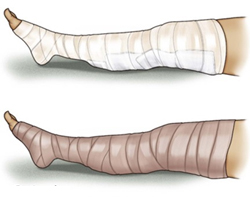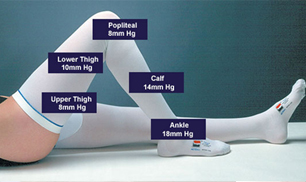 Immediate duplex ultrasonographic examination is indicated for any symptoms that extend beyond the immediate site of treatment. After treatment of large varicose veins by any method, a 30-40 mm Hg gradient compression stocking is applied and the patient is instructed to maintain or increase his or her normal activity level.
Immediate duplex ultrasonographic examination is indicated for any symptoms that extend beyond the immediate site of treatment. After treatment of large varicose veins by any method, a 30-40 mm Hg gradient compression stocking is applied and the patient is instructed to maintain or increase his or her normal activity level.
Compression bandaging for 24 hours, followed by use of thromboembolus deterrent stockings for the remainder of 14 days,
Pregnant patients and those with a strong family history of varicose disease may prevent, delay, or ameliorate the problem by wearing 30-40 mm Hg gradient compression hose whenever standing.
Patients with significant venous reflux are at high risk for progression to chronic venous ulcers that can be very difficult to treat effectively.
With appropriate treatment, the vast majority of patients have a good outcome.
 A person cannot change his or her genes, but a person can keep weight under control, exercise, eat a healthy diet high in fiber, and try to stick to loose comfortable clothing when possible. If an individual is genetically destined to develop varicose veins, they may appear despite all the best efforts.
A person cannot change his or her genes, but a person can keep weight under control, exercise, eat a healthy diet high in fiber, and try to stick to loose comfortable clothing when possible. If an individual is genetically destined to develop varicose veins, they may appear despite all the best efforts.
TED (thromboembolism-deterrent) stockings are the best nonsurgical treatment of varicose veins. They prevent skin breakdown and worsening of the varicosities. Most people have decreased swelling in their feet and less tiredness at the end of the day when using TED stockings.
Prevention/Prognosis:
Varicose veins that a person has now will not go away unless treated. At times the veins may seem more prominent, such as in warm weather, and may look smaller in other months. However, once they appear, they will not go away on their own.
Hence, control/prevention is the key. The earlier a person starts the lifestyle modifications, the better the chances of preventing new varicose veins from forming. In some cases, varicose veins may be one stage in the continuum of chronic poor vein functioning.
Despite all this, some people may progress from having no symptoms, to the development of varicose veins, and then on to problems with leg swelling, and finally to ulcers caused by stagnant blood flow.
- A small number of these people will have deep vein clots as a cause for their signs and symptoms, but most will not.
- The more severe problems, such as skin ulcers, tend to be very difficult to prevent completely. Once these ulcers occur, they are very difficult to cure.
- Even when they are eliminated, these ulcers tend to recur
- A deep vein blood clot has the potential to travel through the bloodstream and lodge in the lung. This is called a pulmonary embolism. Pulmonary embolism does not occur from varicose veins.
- Pulmonary embolism can be life-threatening, because the blood clot can interrupt the circulation of blood in the chest.
- Common symptoms of pulmonary embolism are chest pain and shortness of breath.
- Despite best of treatment and preventive care, there is a 25% chance of recurrence in the same OR adjacent areas.

